Talking Wine, Japan
POSTED ON 08/08/2011I’ve just spent an eye-opening two weeks in China and Japan as a guest judge for, respectively the China Wine Challenge and the Japan Wine Challenge, not forgetting as co-chair of the International Sake Challenge. The competitions are the brainchild of Ronald Brown, a Tokyo wine merchant who’s lived and worked in the Far East for 30 years. In this first part of this interview, he talks about wine in Japan and the Japan Wine Challenge. I’ve posted the names of the trophy-winning wines (below). Next week, in the second part of the interview, Ron Brown talks about the rapidly developing Chinese wine market and how the China Wine Challenge fits into it.
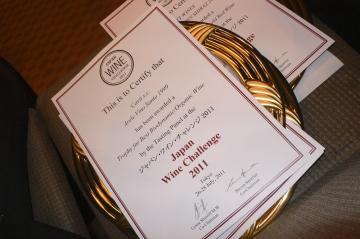 This is to Certify...
This is to Certify...
What’s the story of your involvement with wine in Japan?
I came to Japan for the first time on 6 January 1981. I had been working for Jardine Mathesen in Hong Kong for two years. Jardines is the oldest trading house in the Far East still operating and they had established their Japan branch in 1859. I was in charge of the wine account, which had things like Dom Pérignon and Moët, etc. and that’s what I did for four years. I then was sent by Jardines to Hong Kong and China to run Moët Hennessy-Jardines' tri-venture there. We also had Guinness and Heineken beer and an arrangement with Distillers Company to set up a distillery in China. So I ran that for four years. I got to know China but to be honest I always wanted to come back to Japan, so after a brief period at business school, I took a job running IDV Grand Met in North Asia, based in Japan, from 1989.
The company became Diageo and I left shortly afterwards, in 1994. I was based in Tokyo. We worked with all the large companies. I was a partner of the company worldwide and the partner for North Asia, so I ran all the companies in Japan and North Asia including Micronesia. It was about importation, marketing, sales distribution, and we worked with major companies. Generally we did mostly importation, things like Bombay, Smirnoff, Bailey’s etc.. Then I decided to set up my own thing in Japan.
I had always had vineyards through my Swiss side. I bought my French vineyards in Languedoc in 1984. When I left IDV Grand met in 1994, I started a small company to import wines, La Languedocienne and I teamed up with Steven Spurrier. La Languedocienne was and is today a reasonably senior importer of premium wines to Japan, and we have a very simple mantra: we import family-owned wineries only, which generally own vineyards that produce most or all of their fruit, which farm organically, biodynamically or lutte raisonnée, and which are among the top of their genre, whatever that would be, and which in our view constitute great value for money, e.g. Billecart-Salmon, Laroche, Domaines Schlumberger, and we’re about to start with Antoine Moeuix, we do a variety of wines from around the world including my own wine, Maverick, from Australia.
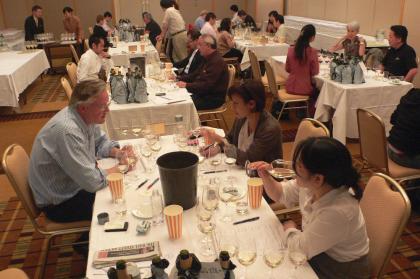 Judging The Japan Wine Challenge, Tokyo
Judging The Japan Wine Challenge, Tokyo
La Languedocienne is like a wine merchant if you like. We exclusively represent for Japan various brands which we then import, distribute, market and sell. Over the last 20 years, most of our competitors, e.g. Jardines, Rémy, Bristol, Barclays, have exited the business because it’s a very difficult market, the margins are quite slim, 85% of retail sales are discounted, with a similar percentage probably in hotels. For a company like ours which really specialises in top-end wineries, that still leaves us with 15% of the market. I think in Japan today more than ever before, you really do either have to be a volume player selling huge quantities of wine at very slender margins or a niche player selling much reduced quantities of wine, still at not huge margins.
The margins over the 30 years I have been in Japan have come down to world standards or below, and that is against the backdrop of having to deliver a wonderful service. We have to deliver within 24 hours of the order. We are expected to do certain things which are the cultural norm in Japan, e.g. take back bottles without questions being asked if they are faulty, and just generally supporting the relationship in many ways, some of them quite onerous financially. The net result is that Japan is not a very attractive place to do business with in the fine wine sector, and even in the lower sector, the margins are extremely small. The main companies are either the large discounters, or the large national brands, mainly beer, companies and they obviously have other products which allow them to get by on less slender margins than the wine industry sector. That in brief is the story of my association with wine in Japan.
What was the objective behind the Japan Wine Challenge?
The Japan Wine Challenge began in 1998 as the brainchild of myself and Robert Joseph after Robert and I met at a FEVS seminar in Paris. Two years later, Joseph decided he would bow out and Steven Spurrier very kindly took the rôle of chairperson. With Steven came John Avery as vice-chairman, and through that we established a very close link with the Institute of Masters of Wine and the WSET, represented by David Wrigley.
I was at that stage very interested in all aspects of the wine market in Japan. I had established a wine magazine in 1997 and we began literally at the same time as three other wine magazines. We had identified the need for a consumer wine magazine and I think three other groups had as well. So overnight there were four consumer magazines of which we were one. One, which was backed by the equivalent of the FT of Japan, went out of business. Two others, Wine Kingdom and Wine Art, were part of very large magazine groups, so they managed to stay, and still stay, in circulation. With our own, I moved it from monthly to quarterly, and then I backed it into the Japan Wine Challenge, so it became the Japan Wine Challenge magazine. At the end of the day, if you’re going to run a competition in Asia, you either need to have your own importation company or a have a very friendly importation company, because the wines need to come through such a route. Certainly China is more difficult than Japan. Japan over the years has got progressively easier, but it’s still a little bit of a professional art importing wines, particularly sample wines, to Japan.
To be honest, I got into the Japan Wine Challenge almost by accident, but the reasons I have stuck with the Japan Wine Challenge are extremely clear. The goal is to enhance consumer awareness and understanding of wine in Japan and to achieve that goal, we work closely with international wineries and local importers. Pernod-Ricard has consistently said that the Japan Wine Challenge has played a key rôle in the evolution of its wine brand sales here in Japan and indeed the stickers are extremely popular. Although a sticker at the end of the day is just a piece of paper, there does seem to be some evidence this is assisting people make their choices in markets where, going to the average discounter, it’s all about price; it’s very confused.
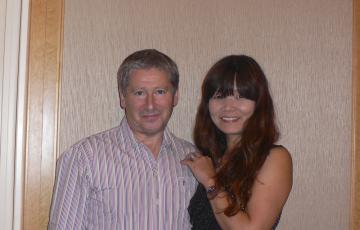 Natty Honda and friend at the JWC
Natty Honda and friend at the JWC
A second key role of the Japan Wine Challenge is the furtherment of wine education in Japan, which is formally carried out through the Institute of Masters of Wine and the WSET, with workshops run by David Wrigley MW and Lynne Sherriff MW at the same time to encourage budding wine professionals to study for a more formal education. In Asia the WSET course and the interest therein has risen exponentially.
And finally the third objective was really to advance the cause of Koshu wine from Japan. Although much Japanese wine following the Japanese wine law is made from wine which is imported in bulk, usually at a preferential tariff, the last few years have seen a realisation by many of the smart producers in Japan that Koshu is indeed their native variety, that it has a wonderful history and that makes a perfectly palatable and actually very interesting wine. It’s not seen as a noble variety, but I always compare it to Chasselas in my native country Switzerland, not because they taste the same but because they occupy the same relative position in the culture and wine history of the country, and I think that Koshu is enjoying a bit of a comeback and thanks to many of the judge’s efforts who participate in this competition, you now see Koshu around the world and every year our Koshu entries increase.
To what extent was the Japan Wine Challenge a vehicle for your company and your brands?
Not at all. It’s always been completely separate. I have never entered any of my own, owned brands into this competition. In fact apart from maybe the first two or three years, we do not enter any of our represented brands, so we leave it to our suppliers if they wish to enter. I think it’s very important that that distinction is made so that there can be no possible overlap or conflict of interest. I do not judge. The judging is very transparent with some of the best judges internationally and from Japan. I suppose I saw it as just another interesting and relevant part of the wine business. I should have said I also had some wine bars. I co-owned the no.1 wine bar in Japan, Tastevin Aoyama. Jancis Robinson, Hugh Johnson, Steven, all the world’s good and great, have all been there. It was then and perhaps still is the no. 1 wine bar in Japan. We had a succession of events and we pioneered the concept of premium wines by the glass, so we had 10 wines by the glass every week, and every night we’d open an additional 10 – 20 bottles. The theory of that was that we always covered the cost of the wine with the first glass and it enabled us to open some very interesting bottles.
I think the Wine Challenge therefore just fitted into my wine world, and we’ve talked a bit about Japan, which is obviously the thrust, but I have always been a vigneron. So I have always had vineyards. I bought my Swiss family vineyards, I bought my first vineyards in the Languedoc, as I mentioned, in 1984, I was asked by Hugh Johnson to enter his project in Hungary. He asked all his friends, so I took a small percentage there. And then 1997, I moved my vineyards to Australia because we were in the Languedoc, we had some beautiful wines, I adore the Languedoc, but even today, the Languedoc is a hard place to do business. I put together a small partner group, we bought four absolutely top vineyards, from across the Barossa and Eden Valley. We’ve cultivated from the start biodynamically, which is how I always farmed in France. We [Maverick] are again a 5-star winery in Halliday.
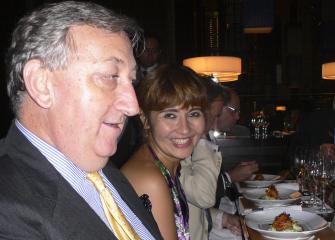 Ron and Mochyra Brown
Ron and Mochyra Brown
How has the Japanese market for wine developed?
When I came here in 1981 the wine market in was tiny. It was 80% so-called Japanese wine, 20% imported wine, very funnily quite similar to the mix in China today. Under both laws, you are allowed to include a very large percentage of foreign origin wine. I don’t know the percentage in China, but I think in Japan it can be 95%. So in those days it was very simple. Locally produced wines were bottled locally, in attractive packaging, which didn’t come 10,000 kilometres around the world, the labelling wasn’t damaged by long sea journeys, and that appealed very much to the Japanese palate and the perception of how a bottle of wine should look. In those days, the market split was approximately 55% white, 15% rosé and 30% red, whereas today there’s almost no rosé and there is roughly 80 – 85% red. Over that time the mix has changed and the Japanese consumer has become more aware of the origin of Japanese wine and so now there’s roughly a 25% share for domestic wine versus a 75% share for imports. So that would be the big change in the market.
Would you say there is a Japanese palate?
When I came here first, roughly a quarter or a third of Japanese domestic wine production consisted of sweet port-like wine, led by a brand called Akadama, which came if I remember correctly in a 1.8 litre bottle. It presented itself as a very traditional wine, and it was really the Japanese version if you like of port wine, not nearly as fortified, but extremely sweet and to a normal Western palate an undrinkable, totally sickly wine. That wine as far as I’m aware doesn’t exist any more. If you compare that with England when I was at Cambridge in the early 1970s, wine consumption then was limited to a very few people who understood fine French wine and then just starting were brands like Hirondelle, Mateus Rosé, Blue Nun and Black Tower, which collectively accounted for a huge percentage of the wine market. In 30 – 40 years the British palate has come of age. Everyone can tell you the difference between a St.Chinian and a Faugères, so in some ways Japan is merely where England was, and I think the evolution of Japan is in some ways very comparable to the evolution of the English wine market. In broad brush terms, that is. Then when you penetrate the veil of course it’s different. It’s a different culture, it’s got different cuisine, even today as we’ve noticed from the judging, there are sharply differing appreciative methods or standards, and that’s called the international wine world.
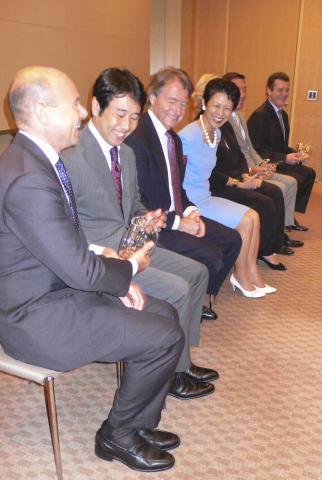 Princess Takamado with Steven Spurrier and award winners at the JWC
Princess Takamado with Steven Spurrier and award winners at the JWC
So one thing I’m aware of is putting any market into a box because for me even after 30 years in this market, the Japan market is quite different from many other markets. The broad brush strokes we can predict, and it’s reasonably clear where the overall trend’s going to go, but I must say that drinking wine a lot with Japanese persons, as I do, we definitely have different tastes. I think the best example I can give you is Riesling. Riesling is my favourite white variety. One of my wines from Australia, the Trial Hill Eden Valley Riesling, which just received a score of 95 in the new James Halliday Wine Companion, is a wonderful example of an Eden Valley / Clare Valley Riesling, and that Riesling sells extremely well in the 5-star hotels in Japan and in certain restaurants that understand Australian fine wine, including Robuchon; and then we come to a grinding halt, and I find that really remarkable. The wine which in my view is best suited to Japanese cuisine if we had to take just one wine would have to be Riesling, but that is not the view of the Japanese wine consumer and I don’t see that changing. The official preference is for high quality Cabernet Sauvignons, high quality Pinot Noirs.
Having said that, we live in a very price-conscious market here and a huge percentage is discounted and very low margin, but even there the propensity for the average Japanese consumer seems to be to look for inexpensive Bordeaux red wine. We have a lot of wine coming in at 2 euros (FOB) from Bordeaux and you can imagine very clearly what quality of wine that is. In fact, since the earthquake on 11 March, everything stopped for a while, attendance in the high class restaurants, many of which are in hotels, many of which are free-standing, has all but collapsed. It’s coming back slowly over the last couple of months, but the reality is that the fine wine on-premise business has reduced dramatically and 60 – 80% would not be an exaggeration. It’s now coming back and the hope is we’ll be back to a semblance of normality by the end of the year.
Conversely consumption of very inexpensive wine has risen exponentially in the last few months. It’s understandable that people are drinking less well, but in more quantity, reflecting the hardships of 2011 in Japan. Off-premise and internet sales are growing at the expense of on-premise, but it’s a trend that’s been happening over the last 10 years during which Japan has been more or less in recession against a backdrop of the ‘Lehmann Shock’ and the crisis of 2009. In fact Japan has undergone 20 years of very sluggish economic performance. Japan’s recent wine history of the last 20 years is a whole set of cycles which sadly are spiralling downwards in terms of price. The yen of course has become ridiculously strong again and so that has played a slight rôle in the whole deflationary process. At the end of the day, it’s reasonable to say that there are many more Japanese consumers than there were 20 or 30 years ago, but that they’re not necessarily drinking better.
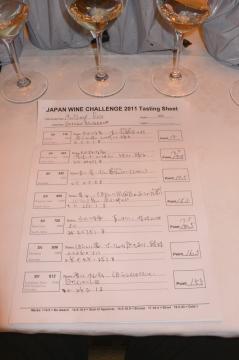
The Japan Wine Challenge
For the full results, see http://www.japanwinechallenge.com/Results/information_results2011.html.
Trophies
Trophy for Best New World White Wine
Shaw & Smith M3 Chardonnay 2009, Australia Shaw + Smith Wines
Trophy for Best Old World White Wine
Orsetto Oro Trebbiano d'Abruzzo DOP 2010, Italy, Casal Thaulero
Trophy for Best New World Red Wine
Gatt High Eden Shiraz 2008, Australia
Trophy for Best Old World Red Wine
Perpetual 2008, Priorat, Spain, Miguel Torres
Trophy for Best Champagne/Sparkling Wine
Cuvée Rare Millésimé 1998, France, Champagne Piper-Heidsieck
Trophy for Best Sweet Wine
Andrew Peller Limited Vidal Icewine, 2010 Canada, Peller Estate
Trophy for Best Fortified Wine
Sercial 1988, Portugal, Vinhos Barbeito Madeira Lda.
Trophy for Best Koshu Wine
Grace Gris de Koshu 2010, Japan, Chuo Budoshu Co., Ltd. (GRACE WINE)
Trophy for Best Biodynamic/Organic Wine
Arele Vino Santo, 1999, Italy, Cavit s.c.
Trophy for Best Value Wine
Le Vele - Verdicchio dei Castelli di Jesi Classico, 2010, Italy, Terre Cortesi Moncaro
Trophy for Best Discovery Wine
Monsoon Valley White Shiraz, 2011, Thailand, Siam Winery Trading Plus Co Ltd

